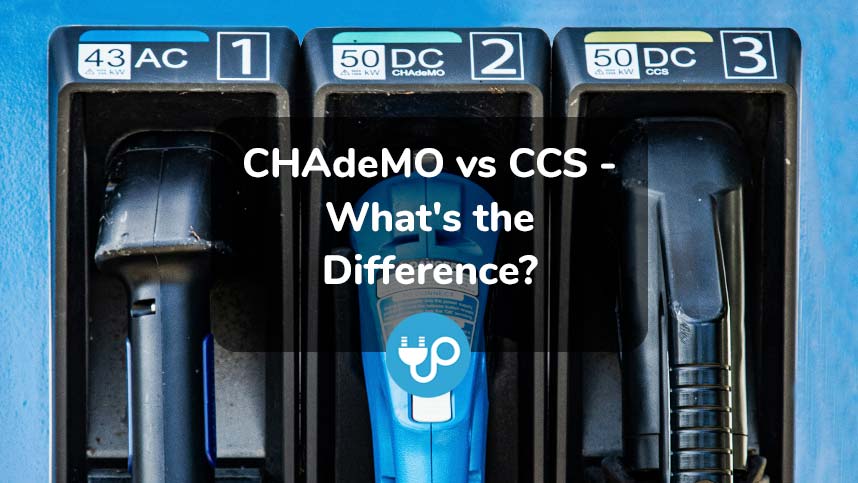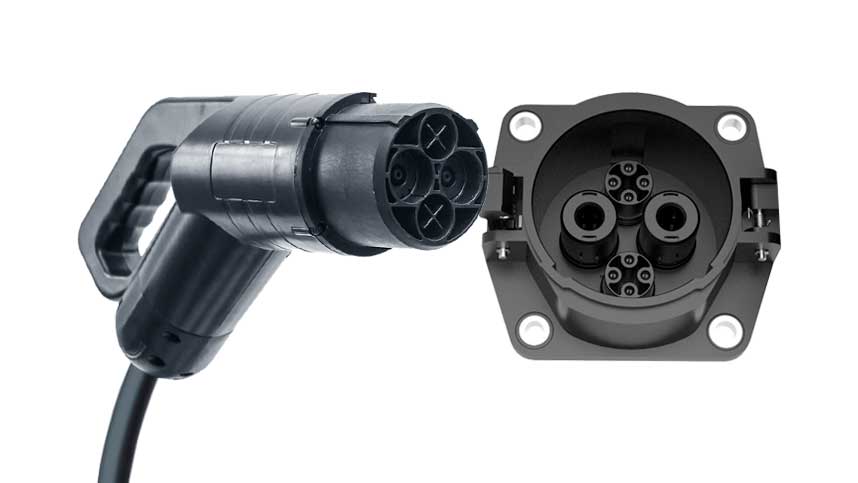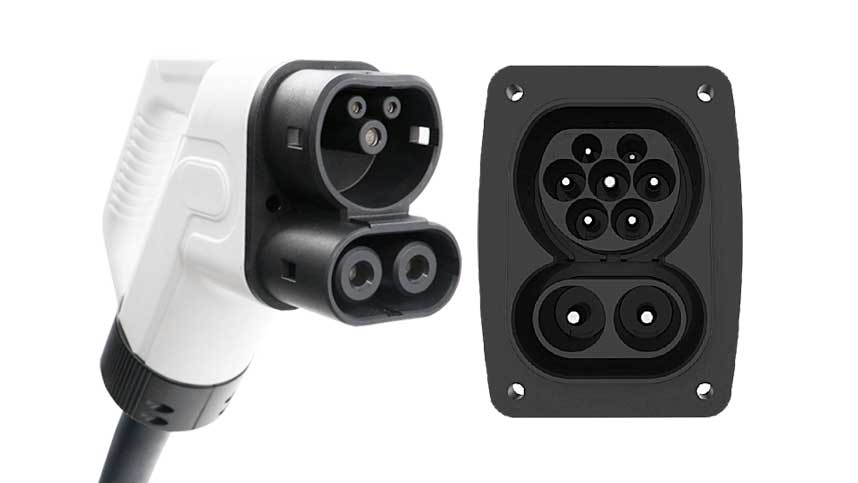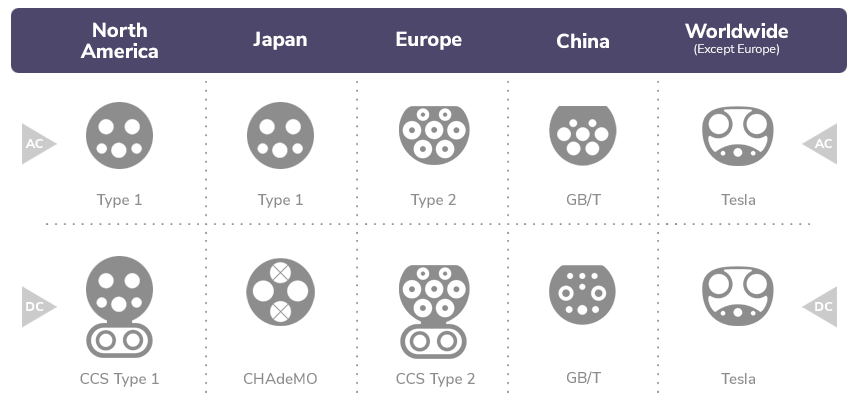
CHAdeMO vs CCS – What’s the Difference?
As electric vehicles become increasingly more commonplace, there’s the need for a reliable and standardized charging infrastructure to charge them.
CCS and CHAdeMO are two of the most popular charging connectors for electric vehicles.
Below we delve into more detail about each one of them and explore their key differences.
Chapters
What is CHAdeMO Charging?
CHAdeMO stands for CHArge de MOve.
It was developed by the Japanese auto manufacturer Nissan in partnership with numerous other Japanese companies.
It has been in use since 2010 and hence is now well established and considered to be a reliable system.
It refers to a DC fast charging system used by electric vehicles.
The process employs a CHAdeMO connector and the vehicle battery through a direct high voltage current, thereby leading to much faster charging than with traditional AC charging.
In fact, rapid charging stations are generally rated at 50kW or higher, leading to a full charge within an hour.
CHAdeMO connectors allow for rapid DC charging at public charging points, and offer the advantage of bidirectional charging.
Indeed, electricity can flow both from the charger into the vehicle, and also the other way round, and on to the house or the grid.
The connector is separate from the Type 1 and 2 connectors that are used in Europe, and it comprises additional pins for DC fast charging.
What is CCS Charging?
CCS stands for Combined Charging System.
It was developed through collaboration by various auto manufacturers, including Ford, BMW, Audi, Porsche, Daimler, Volkswagen and General Motors.
This charging system combines AC and DC charging in a single connector.
As a result, there is improved charging flexibility as the vehicle can be charged using either AC or DC.
The choice will depend on the charging station’s capabilities and on the EV’s needs.
CCS connectors are based on the Type 2 connectors that are used in European countries, with additional pins to allow for DC fast charging.
As CCS charging stations employ a DC fast charging system, this allows for considerably quicker charging times than those carried out by means of traditional AC charging.
A full charge can in fact be carried out within half an hour as these stations are generally rated at 50kW or higher.
Some of the more recent CCS installations are 120kW or 150kW.
There are even CCS charging stations that offer a 350kW charge.
Many auto manufacturers are having their new models use this charging system, including Audi, Kia, Hyundai, Mini, Jaguar, Peugeot, Opel and Citroen, to mention a few.
What’s the Difference Between CHAdeMO & CCS?
The main difference between CHAdeMO and CCS lies in their connectors and charging methods.
When it comes to CHAdeMO, the connector is incompatible with other charging systems.
It is typically used for very fast DC charging.
On the other hand CCS utilises a hybrid connector which supports both AC and DC charging.
While both charging systems need a high voltage direct current supply, a dedicated transformer and communication and control systems which will be responsible for managing the charging process, in the case of CCS charging stations these will need to be integrated with the grid and billing system.
CHAdeMO is more commonly used in Japan and Asian countries, while CCS is becoming increasingly popular in North America and European countries.
This of course is linked directly to the popular auto brands in those particular regions.
For instance, Nissan, Subaru, Toyota and Mitsubshi, which are Japanese brands, support CHAdeMO.
General Motors, BMW and Volkswagen, which are American and European brands, support CCS.
CCS connectors have seven pins, whereas CHAdeMO connectors have nine pins.
It is also important to point out that CCS connectors are compatible with Type 2 connectors, while CHAdeMO connectors are not.
Advantages of CHAdeMO
Some advantages of CHAdeMO include:
- CHAdeMO charging stations allow EV owners the convenience of charging their vehicle while on the go.
- An electric vehicle can be charged to 80% in less than an hour of charging.
- Compatible with several vehicles.
- CHAdeMO charging stations are relatively inexpensive.
- CHAdeMO charging is more affordable than CCS charging.
- Has been used for several years and has been proven to be a reliable and efficient charging system.
Disadvantages of CHAdeMO
Some drawbacks of CHAdeMO include:
- Mostly found in Japan and Asian countries, thereby limiting use in other countries of the world.
- It is only intended for fast DC charging and so vehicles which need AC charging cannot use it.
- Vehicles that do not have a CHAdeMO charging port will need a separate adapter, and so it can be costly.
Advantages of CCS
CCS comes with numerous advantages, including:
- CCS is used by several major auto manufacturers and so it is compatible with numerous electric vehicle models, including General Motors, BMW and Volkswagen.
- With a CCS charging station an EV can charge to 80% in less than half an hour, making it considerably quicker than other charging systems.
- As this system integrates both AC and DC charging functions within a single connector, it is more flexible.
- This system also allows for bidirectional charging, so the EV will also supply electricity to the grid. This is also referred to as V2G.
- CCS is considered as one of the primary ways for fast EV charging in European countries and North America.
- In relation to other fast charging systems it is not that expensive.
Disadvantages of CCS
Some of the cons of CCS include:
- While being popular in Europe and North America, this system is not used much in other parts of the world, and so one will find few charging stations.
- This is a relatively new charging system, and as a result it may not be compatible with older electric vehicle models.
- A separate adapter would need to be purchased in order to use CCS if the vehicle does not have a suitable port.
- CCS charging stations need a rather complex infrastructure and hence installation could be relatively expensive.
Conclusion
As there are various options when it comes to EV charging, and different types of electric car connectors, it is a good idea to have at least a basic understanding of the above.
However, at the end of the day you can simply tell the charging point manufacturer the type of EV that you own, and you will be advised on the models which are suitable.
The choice will depend mostly on where you live as well as the EV that you drive.
Blog Archive
- 25 New Electric Car Brands on UK Roads
- General Election 2024: Major Party Net Zero Policies Compared
- Electric Car Service Costs vs ICE
- CHAdeMO vs CCS – What’s the Difference?
- Mr EV Reviews Joosup
- What is the ZEV Mandate?
- Spring 2024 Budget: No VAT Rate Cut on Public EV Charging
- What is Regenerative Braking?
- Joosup Powers Up Inaugural Everything Electric Show
- Do Electric Cars Pay Congestion Charges?
- The UK Government is Failing Its Own Targets – EV Charger Sharing Can Plug the Gap!
- Do Electric Cars Have Gears?
- Is EV Battery Recycling Possible?
- Christmas Commuting – How to Avoid EV Charge Rage
- Electric Car Tyres – All You Need to Know
- What Price Should I Rent My EV Charger Out?
- Are Electric Cars Cheaper to Run?
- Do Electric Cars Use Oil?
- 70% of UK Councils Have No On-Street EV Charging Plans
- Joosup + waEV-Charge: Electrifying the Future Together!




